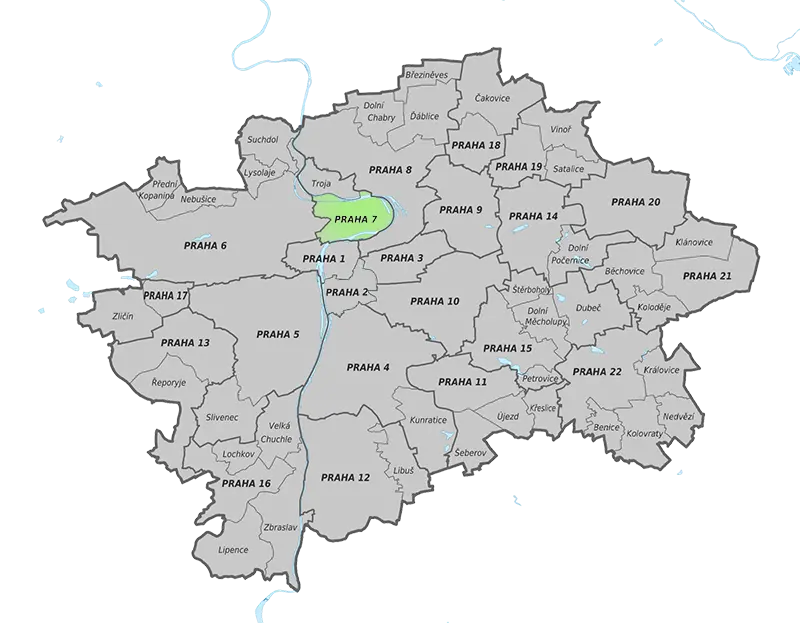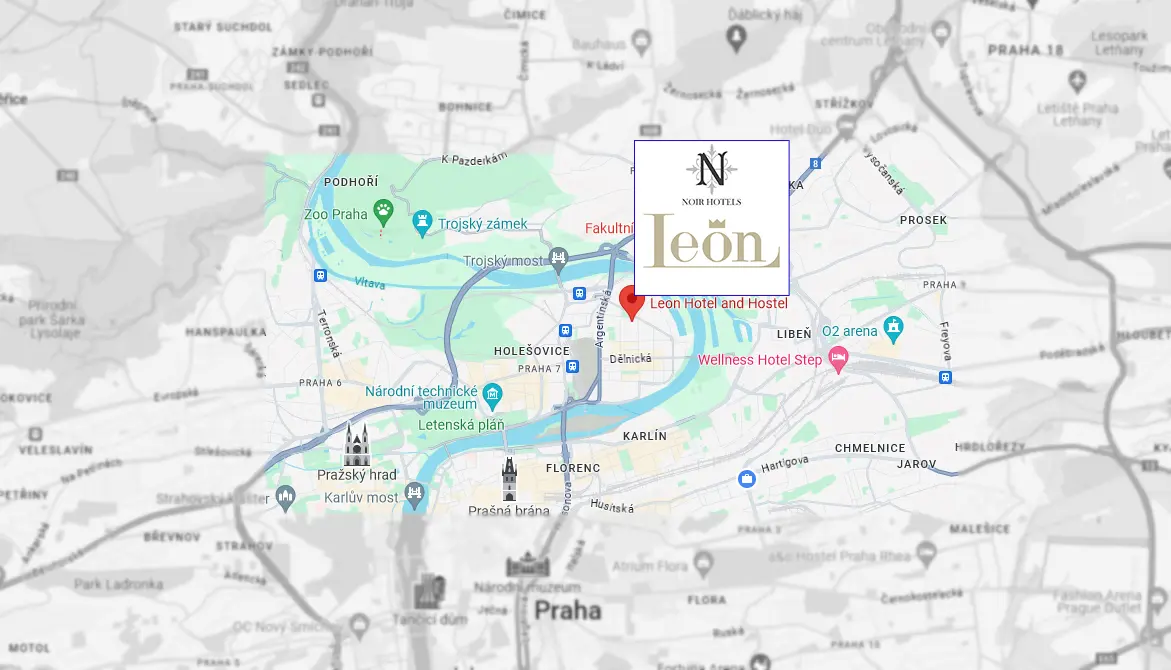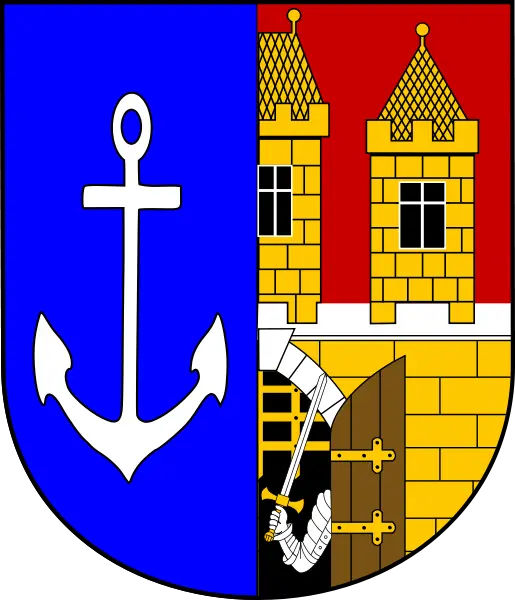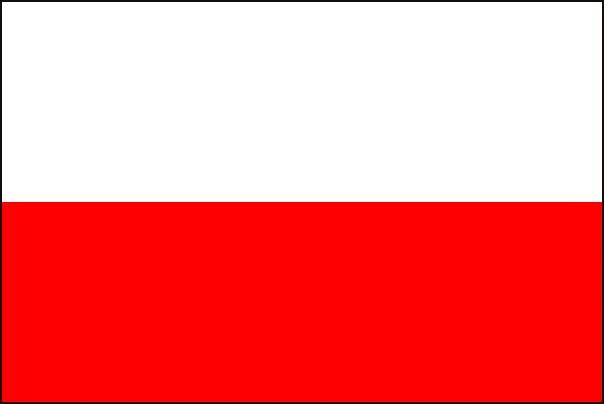Location | Leon Hotel
PRAGUE 7
Prague is divided into a total of 57 city districts. Municipal districts were established for the first time with effect from November 24, 1990 by the now repealed Act No. 418/1990 Coll., on the capital city of Prague. The status and powers of municipal districts are currently regulated by Act No. 131/2000 Coll., on the capital city of Prague, a special law and generally binding Decree No. 55/2000 Coll. hl. city of Prague. A municipal district is an independent unit administered by an elected council, a council and a municipal district office. Just like the capital city of Prague, each district manages its own budget, which is compiled individually according to the needs of the given district.
It includes almost the entire cadastral territory of Holešovice, about half of the cadastral territory of Bubenče and a small part of the cadastral territory of Libeň. Until December 31, 1991, Prague 7 also included the southwestern (lower) part of the cadastral territory of Troja, which became independent within the district as of January 1, 1992 as the Prague-Troja urban district.
It is located north of the historic center of Prague mainly on the left bank of the Vltava and inside its large meander, but a smaller part of the territory also extends to its right bank. It is an extension of the center of Prague and includes areas of dense residential and industrial urban development, as well as commercial zones and extensive parks and natural areas (Letná, Stromovka, Troja with zoological and botanical gardens and nature reserves). It is connected to the center by the red line C of the Prague metro and the tram system.

Internet source: wikipedie
Currently: the official website of Prague 7
- Population: 44 442 (2021)
- Area: 7,14 km²
- Number of houses: 1 536 (2021)

Visual identity of Prague 7
The emblem of Prague 7


The flag of Prague 7

3 main dominants
Despite its relative youth, Prague 7 is a place where you can admire many architectural and technical monuments. Long before the official establishment of the district in 1884, important buildings were built here to this day (Mayor’s Letohrádek, Rudolf’s tunnel, Letná fortifications, etc.). However, it was not until the rapid development of the district in the second half of the 19th century that it imprinted its present face. But the construction industry did not stop even later, and thanks to this, we can without exaggeration consider Holešovice, Letná and part of Bubenče today as a kind of practical textbook of modern architecture.
Veletržní palác | Fair Palace
One of the dominant features of Prague 7 is undoubtedly the monumental building of the Trade Fair Palace. In its time, the very modern building was designed by the architects Josef Fuchs and Oldřich Tyl. The reinforced concrete frame with six-meter-long brackets was especially unique. Despite the huge volume, the whole building looks very fresh. The internal layout was designed in accordance with the original purpose of the building, i.e. primarily the organization of fairs. The investor and operator was the company Pražské zrokové veletrhy, which also had “under its thumb” the neighboring area of the so-called old exhibition center. The palace was supposed to be the first part of the ambitious project of the so-called fair market city, which was to grow in the triangle between Dukelské hrdinů, Veletržní and Strojnická streets. It was to include a second palace for holding fairs and a hotel. However, it was not realized due to the crisis in the 1930s, but also because of the huge problems with the debts from the construction of the first palace.
In addition, the use of the building in times when regular sample fairs were not held proved to be a big problem – parts of the palace were rented out to private entities, but cultural events, concerts or exhibitions were also held here. A restaurant was opened on the terrace with a beautiful view, and later also a cinema in the basement of the palace. During World War II, the building was confiscated by the occupation authorities. After the rise of the communists, the building was used as the headquarters of foreign trade companies. In August 1974, the palace burned down, it took six whole days to put out the fire, and for a long time it was the biggest Prague fire ever. The rapid spread of the fire and the level of devastation were also contributed to by the amount of unskilled building modifications carried out mostly with the help of highly flammable materials. At first, the building’s fate seemed sealed. In the end, however, it was decided that the palace would be repaired and the National Gallery’s collection of modern art would be housed here. Today, in addition to NG, the progressive Studio Hrdinů theater is also located here (on the site of the former Veletrhy cinema). However, there is currently talk of moving the National Gallery’s collections from the palace, the reason for which is supposed to be the high energy demand of the building.
Letenský zámeček | Letensky Castle
Since 1863, there has been a neo-Renaissance style excursion restaurant in Letenské sady with a square tower on the east side, which was built according to the design of the architect Ignác Ulmann (1822-1897). It served as an excursion restaurant for the people of Prague – in the 19th century, the adjacent orchards were a popular destination for outings. The castle building is located approximately on the site of the original Belvedere summer house, which stood here in the first half of the 18th century and which was destroyed by French troops after the siege of Prague. The importance of the castle increased during the Jubilee National Exhibition in 1891: a cable car led to it from the embankment (from the then Eliščina bridge) and Křižík’s electric tram started nearby, which transported visitors to the gate of the Bubeneč exhibition center. At the end of the 19th century, a music pavilion was also created, a simple cast-iron gazebo in which numerous musical productions took place. The restaurant owned by Prague was operated by various tenants, while it was particularly popular in the period before the First World War, when the “Huňkův velkorestaurant” operated here. Even today, the place is very popular among both locals and tourists, mainly thanks to the amazing view of a large part of Prague from the restaurant’s garden.
Kaple sv. Maří Magdaleny | Chapel of St. Mary Magdalene
It is one of the oldest religious buildings in Prague 7. It was built in 1635 in the early Baroque style by Jan Chrysostomos Trembský, provost of the Cyriak Monastery (Crusaders with a Red Heart). Jan Dominik de Barisis, a builder from northern Italy, gave the elliptical rotunda its architectural face, who built, among other things, the church of St. Salvatore. The chapel with a very rich interior stucco decoration served not only the members of the order that had it built, but also the winegrowers from the surrounding vineyards, and rowers often rested there after sailing through the nearby rowing sluices. Like thousands of sacred buildings, the rotunda did not “survive” the ecclesiastical reforms of Joseph II and was abolished. It then served as a wood storehouse for the nearby first military and later civilian swimming pool. It began to serve its original purpose again in 1908 after the opening of the nearby Čech bridge. He influenced the existence of the chapel once more. In the mid-fifties of the 20th century, the entire chapel had to be moved by several tens of meters during the renovation of the bridgehead. The demanding task was undertaken by the team around CTU professor Stanislav Bechyně and on the 3rd-4thFebruary 1956 the chapel was successfully moved.
And you can find many more on the Prague 7 resource page, from which we drew: 

Other attractions and important monuments in the vicinity
Smetana Theater (1886-1887, New German Theater)
Theater in Vinohrady (1905-1909, “Vinohrady Theatre”)
Czech Radio Building (1929-1931, Czechoslovak Radio)
Hlavní nádraží (1901-1909, Emperor Franz Josef I., Wilsonovo, Hlavní nádraží, Wilsonovo)
National House in Vinohrady (1893-1894, formerly ÚKDŽ, later KDŽ)
Vinohradská falconry in Riegrovy sady
Vinohradská tržnice (1902), one of the Prague markets
Water Tower (1891)
Vinohrady Cemetery (1885)
Chapel of St. families (1755)
Hus’ Choir (1932-1935)
Church of Saint Ludmila (1888-1893)
Church of the Sacred Heart of the Lord (1928-1932)
Archbishop’s High School in Prague
Václav Hollar Art School
The Čapk brothers’ semi-detached house (1928-1929) in the villa colony of the Association of Journalists (1923-1929)
Gröbe’s villa (1871-1888, Villa Gröbe, “Grébovka”), with Dolní Landhauska and park
Kotěr’s villa (1908-1909)
Laichter House (1908-1909)
Schnirch House (1875)
Šaloun’s Villa (1908-1909)
Villa Osvěta, birthplace of Jan Masaryk





